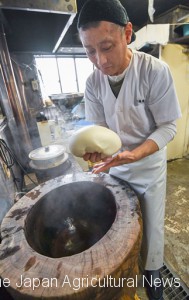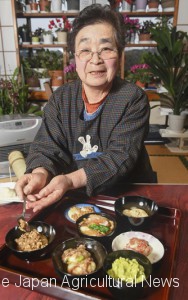
“Kuramoto Restaurant Sekinoichi,” of a 100-year-old sake brewery “Sekinoichi Shuzo” serves approximately 20 different seasonal mochi dishes. (in Ichinoseki city, Iwate Prefecture)
IWATE, Jan. 7 – Mochi is indispensable for the new year’s day in Japan, but in Ichinoseki city, Iwate Prefecture, it’s not just for new year’s day. Ichinoseki has its own mochi culture and it’s trying to bring more people from all over Japan, year-round, by focusing on this local heritage.

Shigeo Suzuki (61), an owner of Daifukuya founded in 1912, uses a mortar handed down by a local farmer.
People in Ichinoseki eat mochi all around the year. They boast over 300 different ways of serving mochi, some with traditional toppings like “zunda (sweet crushed edamame green soybeans),” “shoga (sweet ginger sauce),” “ebi (fresh-water shrimps),” and “natto (fermented soybeans)” and others with contemporary ideas The people also serve “mochi honzen (full-course mochi dinner)” at weddings, funerals and other special occasions. There are more than 30 shops and restaurants offering mochi specialties.
Daifukuya is one of the favorites of a 93-year-old local ex-farmer, Kiyoko Sasaki. She often goes to the long-established local rice cake restaurant for more than 50 years. “Today, I came here to eat mochi for lunch. In Ichinoseki, mochi is part of our daily life,” she smiled.
The history of mochi culture in Ichinoseki can date back more than 400 years to the Edo Period. Date clan, a local samurai family which ruled over the rice-producing region, adopted mochi as offering to the God or ceremonial dinner. The custom spread to the commoner who gradually invented new and unique ways to enjoy mochi.
Some of the popular mochi dishes today are very new and stylish. The local restaurants now serve all sorts of different dishes such as “Mochi Fondu”, “Mochi Lasagna” and “Mochi Milk Tea.”


